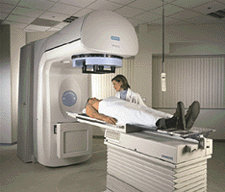Radiation therapy uses high-energy x-rays (ionizing radiation) to stop cancer cells from dividing. A rad is the scientific unit of measure of radiation energy dose. A patient who receives radiation therapy as a treatment for cancer will receive several thousand rads over a very short period of time (weeks or months). A typical x-ray contains far fewer rads. For example, modern mammography systems used to take x-ray images of the breast use approximately 0.1 to 0.2 rad dose per x-ray.
During radiation therapy, x-rays deposit energy in the area being treated, damaging the genetic material of cells and making it impossible for these cells to divide. Although radiation damages both cancer cells and normal cells, the normal cells are usually able to repair themselves and function properly. Like surgery, radiation therapy is a local treatment; it only affects the cells in the treated area. Radiation therapy may be used to treat localized solid tumors, such as cancers of the skin, head and neck, brain, breast, prostate and cervix. Radiation therapy can also be used to treat leukemia and lymphoma (cancers of the blood-forming cells and lymphatic system, respectively).

The patient is positioned and consulted by the technologist prior to radiotherapy. The "upside down L" device is a linear accelerator, which delivers high energy x-rays directly to the tumor.
External beam radiation therapy is delivered by means of a linear accelerator. Linear accelerators use powerful generators to create the high energy x-rays for external beam radiation therapy. The linear accelerator has a special set of lead shutters, called collimators, which focus and direct the x-rays to the tumor.
Radiation therapy may also be delivered by placing a small amount of radioactive material directly into the tumor (brachytherapy). Interstitial irradiation, and intracavitary irradiation are types of brachytherapy. Some patients may receive both types of treatment.
External beam radiation therapy uses x-rays, or photons, which are sometimes called "packets of energy," to treat cancer. The higher the energy of the x-ray beam, the deeper the x-rays penetrate into the target tissue. Linear accelerators produce x-rays at various energies.
The large "L-shaped" design of the linear accelerator allows it to rotate, delivering radiation from all angles. Multiple angles allow the maximum amount of radiation to be delivered to the tumor while delivering a minimal amount of radiation to the surrounding healthy tissue.
Gamma rays are another form of photons used in radiotherapy. Gamma rays are produced spontaneously as certain elements (such as radium, uranium, and cobalt 60), which release radiation as they decompose, or decay. Each element decays at a specific rate and gives off energy in the form of gamma rays and other particles. X-rays and gamma rays have the same effect on cancer cells.
Many of the original cobalt gamma ray systems have been replaced with linear accelerators. Cobalt systems can not deliver the higher power radiation that is possible with a linear accelerator, and thus may not be as effective at destroying cancerous tumor. Also, the radiation produced by a linear accelerator can be turned on and off, whereas the cobalt system consists of a radioactive source material which is always on.
One advanced application of gamma rays is the successful treatment of brain tumors using a system referred to as a "gamma knife". The gamma knife delivers precise beams of radiation to the diseased brain tissue or tumor from a large number of directions. The gamma knife uses a concentrated radiation dose from Cobalt-60 sources. A total of 201 beams of radiation intersect to form a powerful tool focused on a targeted area of abnormal or cancerous tissue within the brain. The gamma knife is very precise and it damages and destroys unhealthy tissue while sparing adjacent normal, healthy brain tissue. For more information on the gamma knife visit www.elekta.com.
Updated: June 10, 2008



